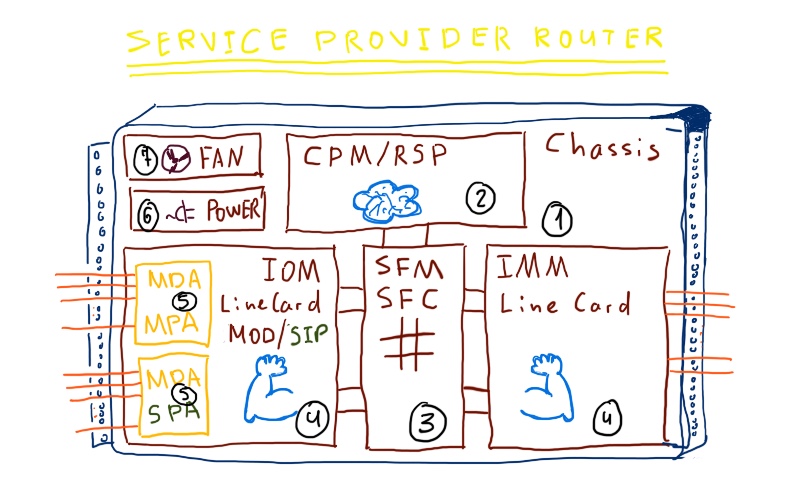Hello my friend,
This article isn’t the same as I’ve written previously. I won’t provide the configuration of routers comparing syntax at Cisco IOS XR and Nokia (Alcatel-Lucent) SR OS. Instead I’ll review the hardware architecture of service provider routers and how mentioned vendors call their parts. As you can imagine their architectures are the same.
“Do”s and “Don’t”s
I won’t compare performance, prices or feature set. I have neither possibility nor desire to do it. Prices are always subject for commercial negotiation and may significantly differ from global price list (GPL). Performance is very specific issue, because measurements must be done in certain conditions, which are far way from white papers. These conditions always depend on each providers network and its traffic pattern. It’s possible to make measurements for Internet traffic mix (IMIX), but it also may be far away from reality if we have pure mobile operator network. Feature set isn’t interesting for me right now, because I don’t fill in bidding documentation for tender.
What I will do, I’ll explain the architecture of the typical modular service provider router, its components and main operation principles, because they are the same. This information will be valuable, when you read documentation or speak to engineers, who have experience with another vendor.
Lego for network engineers
Typically service provider router has modular architecture, if we are speaking about aggregation nodes (AN), provider edge (PE) or provider core (P) routers. In Nokia (Alcatel-Lucent) we have SAR 7705, SR 7750 and XRS 7950 routers. In Cisco we have ASR 9000, NCS 6000 and CRS-1/3. There are also numerous other models, but they in general have the same architecture, if they are modular. Just take a look at Nokia SR 7750 12e and Cisco ASR 9910 routers. Find 10 differences:

I don’t compare internal hardware architecture, ASIC/NPU structure or packet encapsulation in fabric. Only overall architecture and operation.
Each modular router can be presented with the following image:

Let’s review what each component does:
- (1) Chassis is a box, where we build our service provider router. Its size defines the number of modules, which we can insert in it.
- (2) Control board is a “brain” of the router, which is responsible for all control plane (OSPF/IS-IS/BGP/PIM/LDP/RSVP-TE/etc) and management plane (SSH/Telnet/SNMP/etc) operation. Nokia (Alcatel-Lucent) calls this module Control Processing Module (CPM). Cisco calls it usually Route Processor (RP) or Route Switch Processor (RSP) in ASR 9000, NCS 6000 and CRS-1/3 routers. In Cisco 7600 and Catalyst 6500 (IOS devices) it’s called Supervisor (Sup). In critical environment two CPM/RSP installed into the service provider router. Dual CPM/RSP also doubles performance of the router backplane (see the next point).
- (3) Fabric or Switch Fabric is internal backplane that spans all modules and provide data transmission services between them. Nokia (Alcatel-Lucent) calls it Switch Fabric Module (SFM). Cisco calls it Switch Fabric Card (SFC). Usually separated switch fabric is used at high-end routers, where the ultra high performance (up to 1 Tbps per slot and more) is needed. In other cases switch fabric is often integrated into control board. In Nokia (Alcatel-Lucent) such module is called SF/CPM. In Cisco switch fabric is integrated into RSP, which are used in ASR 9000. If you need more performance, you just add additional SFC cards (not in all models possible).
- (4) Line card is the board, which is used for connecting interfaces and performing traffic forwarding. Line card is a Cisco’s term, which is being actively used by other vendors as well. Another term, which was mainly used previously and mainly relates to Catalyst switches, is switching board. Nokia (Alcatel-Lucent) has two different types of line cards: Integrated Media Module (IMM) is a line card with fixed number/type of ports and Input/Output Module (IOM) is a line card with possibility to install modules, which actually have interface. At one IOM it’s possible to install such modules. Cisco has an analog to IOM, which are called MOD (MOD80, MOD160, etc) line cards. The previous analog, which supports STM and other serial services as well, is called SPA interface processor (SIP).
- (5) Module that is installable into certain type of line card (Nokia’s (Alcatel-Lucent) IOM and Cisco’s MOD/SIP). Nokia called this module Media Dependent Adapter (MDA). There are different types of such MDA: 1/10/40/100G, STM and so on. In Cisco the module type depends on line card type. If there is MOD card, then module is called Modular Port Adapter (MPA) and it supports different Ethernet types 1/10/40/100G. If there is SIP card, then module is called Shared Port Adapter (SPA) and it supports STM and other serial interfaces.
Certain services (i.E NAT) demands additional modules, because they aren’t being processed by line card or control board directly. Nokia (Alcatel-Lucent) calls such module Multiservice Integrated Service Module 2 (MS-ISA2), which can be inserted into IOM. There is also dedicated line card, which is called Multiservice Integrated Service Module (MS-ISM) and have two integrated MS-ISA2 on board. Cisco also has such specific line card, which is called Integrated Service Module. - (6) Power supply doesn’t relate directly to traffic forwarding, but it provides the power to the line cards and control board. If you don’t have enough power, some part your equipment may not boot (some of your line cards for example). Usually the service provider routers is designed so that even fully equipped with all boards router tolerates the outage of at least one power supply.
- (7) Fans or Fan tray is a part of the router that cools all other components. Each service provider router has a temperature range within which it operates. If the temperature is higher (or lower, though it’s usually not the case as fans can’t heat the device) then the range allows, then the router can be damaged.
There are also some additional components that are highly desirable usually (and that must be purchased separately), like rack mount kit or cable organizer.
Though in general there is more or less parity between modules, each vendor has its own specific module, which another doesn’t have (or least I haven’t found them). As an example, Cisco ASR has Virtualized Service Module (VSM), which allows you to run virtual machines (VM) directly at router for any your purpose. Nokia (Alcatel-Lucent) routers has specific line card called Integrated Service Module – Mobile Gateway (ISM-MG) for processing mobile traffic from 2G/3G/4G and Wi-Fi.
Small brothers
Besides big monstrous modular routers there are also small fixed service provider routers that have fixed configuration and all components being integrated. They are usually used as cell-site gateway (CSG) or customer premises equipment (CPE). For example we have Nokia (Alcatel-Lucent) SAR 7705 portfolio, which has the smallest 1RU (rack unit) routers with fixed number and type of interfaces. In Cisco we have ASR 901 or 920 Series routers, which follows the same 1RU fixed ports architecture.
Lessons learned
Review of the actual data sheets has provided many interesting information about current modules and interoperability. Not all new line cards are supported with old CPM/RSP and vice versa. When you configure router you should always take care about such possible problems and check the modules interoperability before buying something.
Conclusion
Knowing the vocabulary is necessary for successful operation. When I met the Nokia (Alcatel-Lucent) SR 7750 description, I was confused by this IMM/IOM and so on, as with Cisco I used only “line card” term. I hope that this article will help you to understand, what network guys at presentations talking about.
Support us
BR,
Anton Karneliuk







Thank you, your overview was very useful to me.
I have started reading all the cisco-nokia articles and I really want to thank you for this extra informational material.
Nicely explained, helped me a lot ….
Hello Yateen,
we are glad that helped you, thank you for the feedback.
Cheers,
Anton